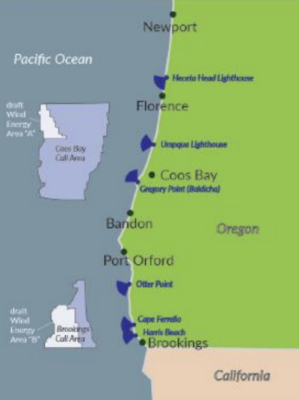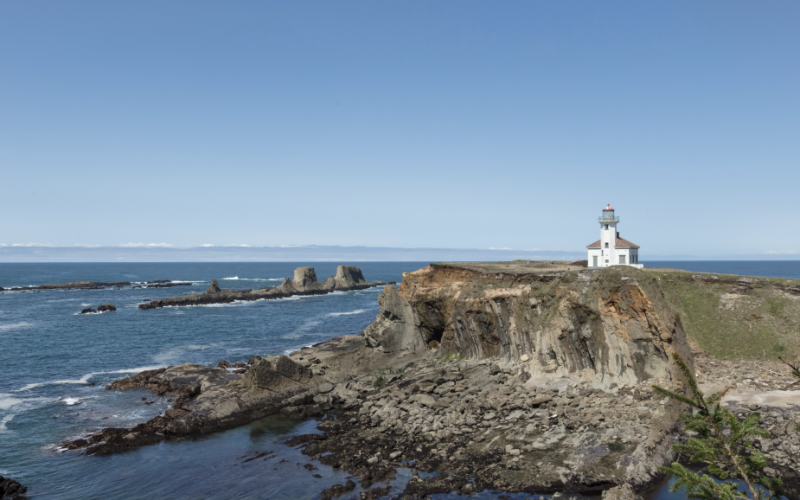Federal energy planners say their decision authorizing offshore wind development off the Oregon coast will avoid most areas that were identified as important for commercial fishing.
As finalized by the Bureau of Ocean Energy Management, the Coos Bay wind energy area is 61,204 acres located 32 miles from shore. To the south the Brookings wind energy area is 133,808 acres, about 18 miles from shore.
“We will continue to work closely with Tribal governments, federal and state government agencies, ocean users, coastal communities and all interested stakeholders as we move forward with our environmental review,” BOEM Director Elizabeth Klein said in announcing the decision.

BOEM’s Oregon planning met with deep skepticism from commercial fishing groups, local governments and tribes. In a statement Oregon Gov. Tina Kotek said the state support renewable energy but must continue working with those groups.
“As BOEM moves forward with establishing a federal offshore wind leasing process this year, Oregon is committed to developing a robust and transparent state roadmap to inform offshore wind opportunities,” said Kotek. “This state roadmap will also ensure that coastal communities and Tribal nations are consulted throughout the process, in close coordination with BOEM.”
“We will continue to promote active engagement with Tribal nations, local communities, and other ocean users in the state. We will ensure that all decisions are transparent and based upon the best available science and knowledge.”
The changes seem to do little to assuage fishermen.
“This is a slap in the face to the many stakeholders who have been trying to engage with BOEM for the last few years,” said Heather Mann, director of the Midwater Trawlers Cooperative. “BOEM is a rogue federal agency pushing a dangerous agenda largely unchecked.”
The wind energy areas are still “habitat for marine mammals and include nursery grounds for important fish species,” said Mann. “BOEM is pitting renewable energy against sustainable food production.”
“We gave BOEM our track lines for where we fish, and I guess they have decided that our businesses and livelihoods are worth trading off to create gigantic wind farms,” said Chris Cooper, a cooperative member and fourth-generation fisherman. “We will not be able to fish in these areas and we have no idea what the impact of these installations will be on the fish species found in there.”
The trawlers’ cooperative quoted a January letter to BOEM from Oregon’s Coastal Caucus:
“Coastal community members and individuals tied to the fishing industry have overwhelmingly spoken with great opposition towards offshore wind. These concerns have been echoed by marine scientists, engineers, environmentalists, tribes, and coastal municipalities. We cannot move forward with offshore wind in Oregon until the needs and concerns of these groups have been addressed.”
Tribal officials said they learned late of BOEM’s final decision Tuesday, and are still concerned about local economic impacts on fishing jobs and visual impacts from future floating wind turbine arrays.
“Despite a federal obligation to consult on a government-to-government, the Tribe learned yesterday of BOEM’s impending decision from officials with the Oregon Governor’s office,” said Brad Kneaper, tribal council chair of the Confederated Tribes of the Coos, Lower Umpqua, and Siuslaw Indians.
“BOEM had the courtesy to communicate its decision to the State well ahead of its public release and waited until the eleventh hour to send the Tribe an email about its decision. This illustrates well the failure of BOEM to meet its obligations to consult with the Tribe and to meaningfully consider its concerns.”
“BOEM has failed to recognize that wind development has impacted the Tribe and has failed to assure that wind energy development will do good and not harm the Tribe, its members, and the greater coastal community. The Tribe will not stand by while a project is developed that causes it more harm than good – this is simply green colonialism.”
The joint tribal council in November 2023 expressed opposition to offshore wind development off Oregon. Along with concerns about potential impact in commercial fishing and the ocean environment, the tribes have stressed the cultural importance of the seacoast.
“As a confederation of coastal tribes deeply dependent on the Ocean and its rich resources, we assert a direct interest in the viewshed extending from our shores, encompassing a distance of at least twelve nautical miles beyond the continental shelf,” said Tribal Chief Doug Barrett. “We believe it is our inherent right to have the ability to see across our viewsheds, as this direct connection is integral to our cultural practices and traditional way of life.”
BOEM’s Feb. 14 publication of a notice in the Federal Register started the clock ticking on a 30-day public comment period. The agency says it will hold another public comment period if BOEM moves forward with a lease sale in either of the wind energy areas.
The American Clean Power Association hailed the WEA designations and said it looks forward to a lease sale.
“Designating commercially suitable, environmentally sound areas of the Pacific Ocean for offshore wind energy moves the region one step closer to a clean energy future,” said Anne Reynolds, ACP’s vice president form offshore wind. “We applaud BOEM for listening carefully to Oregonians while ensuring that Oregon offshore wind can be responsibly developed.”







